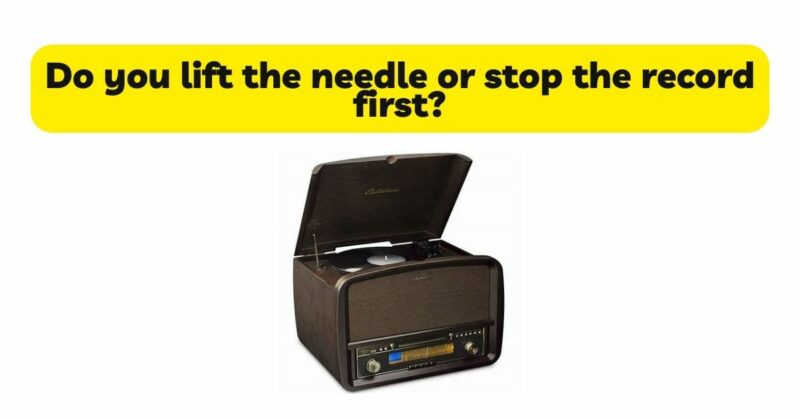Operating a turntable is an art form that requires precision and care, particularly when it comes to lifting the needle. The question of whether to lift the needle or stop the record first has sparked considerable debate among vinyl enthusiasts. In this article, we will explore the arguments on both sides of the discussion, examining the potential impact on sound quality, record preservation, and the overall listening experience. By considering the factors at play, you can make an informed decision regarding the most suitable approach for your turntable setup.
- The Case for Lifting the Needle First: Advocates of lifting the needle first argue that it minimizes wear and tear on both the stylus and the record. By lifting the needle before stopping the record, you can ensure a controlled and precise movement, reducing the risk of accidental scratches or damage to the grooves. This method allows for a gentle lift, promoting longevity and preserving the record’s condition.
- Preserving Sound Quality: Sound quality is a paramount concern for vinyl enthusiasts, and proponents of lifting the needle first contend that it helps maintain optimal playback. Lifting the needle before stopping the record eliminates the potential vibrations and mechanical noise that may occur when the stylus remains in contact with the grooves while the platter slows down. This approach ensures a cleaner signal path, reducing the risk of unwanted noise or distortion during the playback process.
- Avoiding Unintended Resonances: When the needle remains in contact with the spinning record while the turntable slows down, there is a possibility of unintended resonances affecting the sound quality. These resonances can be transmitted through the tonearm and platter, resulting in audible vibrations and potential distortions. Lifting the needle before stopping the record prevents these unintended resonances, promoting a cleaner break in playback and a smoother transition between records.
- Conserving Record Life: Vinyl records are delicate and susceptible to damage, and proponents of lifting the needle first argue that it helps extend the lifespan of records. By lifting the needle before stopping the record, the risk of accidental scratches or damage to the grooves is significantly reduced. This cautious approach minimizes the wear and tear on the record’s surface, ensuring that it can be enjoyed for years to come.
- The Case for Stopping the Record First: Contrarily, some argue that stopping the record first before lifting the needle is a viable approach. They contend that modern turntables and cartridges are designed to handle the process smoothly, without causing any significant damage or audible disturbances. Stopping the record first can be seen as an efficient and convenient method, eliminating the need for a separate needle lift action.
- Personal Preference and Turntable Considerations: The decision of whether to lift the needle or stop the record first ultimately comes down to personal preference and the specific characteristics of your turntable setup. Factors such as the quality of the turntable’s motor, the design of the tonearm, and the stylus suspension all play a role in determining the most suitable approach. It is essential to consider the manufacturer’s recommendations and guidelines specific to your turntable model, as these can provide valuable insights into the optimal needle lift technique.
- Other Factors to Consider: While the needle lift technique is an important aspect of turntable operation, other factors also contribute to sound quality and record preservation. These include proper record handling, regular cleaning of both the stylus and the vinyl, appropriate turntable setup and calibration, and the use of high-quality cartridges and styli. Paying attention to these factors alongside the needle lift technique will further enhance the performance and lifespan of your records.
Conclusion: The debate of whether to lift the needle or stop the record first is a matter of personal preference and the specific characteristics of your turntable setup. Advocates of lifting the needle first emphasize the potential benefits for record preservation and sound quality. On the other hand, proponents of stopping the record first argue for the convenience and efficiency of a single action. It is crucial to consider the condition of your records, the quality of your turntable, and your desired listening experience when making a decision. By balancing caution and convenience, you can find the needle lift technique that suits your needs, allowing you to fully enjoy the beauty of vinyl playback while maintaining the integrity of your cherished records.


